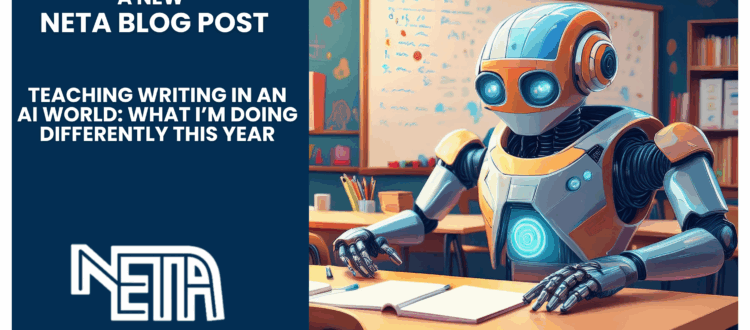Teaching Writing in an AI World: What I’m Doing Differently This Year
Written by: Evi Wusk
Last year, I was working as an educational technology professor when I was part of a group who created Writing & AI: Navigating the Gray Areas, a multimodal resource for teachers (link here). At the time, I thought a lot about the “big picture” questions: What does AI mean for writing instruction? What’s the role of the teacher when a machine can draft an essay in seconds?
This year, though, I’ve got a new class—first-year college writing (English 1010), the same class many high school juniors and seniors take for early college credit. Suddenly, the gray areas aren’t so abstract. They’re right in front of me, in the faces and voices of my students.
This article is a window to my classroom as I try to navigate the waves of AI right alongside my students. I know there are things I’m not doing right, but there’s one thing I know for sure: I don’t want to do the same old same old with writing instruction.
So… the first day of the course, I launched with an activity called “Is this cheating?” Students opened this AI thread (that I begged/borrowed/stole from someone who gave us permission at the NETA conference–Sorry I don’t have a citation!) On the thread, a young writer goes back and forth with ChatGPT. The tool doesn’t spit out an essay; instead, it nudges her thinking, offers feedback, and helps shape her words like a writing coach. I then asked my own students: Is this cheating? I wanted this conversation to set the tone: we’d use AI as part of the writing process, not as a shortcut. With that framing, I made a few key moves in planning my class:
Narrative as anchor: Storytelling highlights students’ lived experiences and perspectives, which is harder for AI to replicate, so I wanted to focus here. I think this skill and its components (sensory details, navigating time, introducing conflict and characters, highlighting growth through your experiences) matter more now than ever. I used to think of narrative as elementary… I’m starting to think of it as the top of the pyramid. What if the new Blooms Taxonomy has connection at the top? What if the ultimate type of writing is that that reminds us we’re not alone, writing that helps us connect? I’ve heard some people say that evaluation should go at the top, that writing will be more about evaluating outputs, but I personally think that the more AI/Generic stuff I read, the more hungry I am for real human stories coming from humans. The “touch grass” movement might have more to do with education than we think.
AI as process, not product: Students use AI for brainstorming, gathering perspectives, or organizing sources, but they shape the thinking and final work themselves. Guy Trainin at UNL has a great short video (link here) about ideation. AI is an amazing thought partner. I’ve also been playing with random freewriting in AI and then having it reverse outline essays–which I then write from the outline. I’m curious how we might use AI in creative ways to get at tasks with better results. I’m not sure I will never have AI do writing for class… but I’m starting here.
Multimodal final projects: Students will choose formats like podcasts, video essays, infographics, or blogs—grounded in research and citation instead of writing a formal long-style paper. It’s still important for them to learn to write, but I keep asking–what would it look like to create a project or an assignment that is non- or less-AI-able? That is a hard ask, but I think the question is important. Are there times to teach things AI can so easily do? Absolutely… but let’s be choosy about why we’re taking the time. Is teaching this even worth it? I keep asking myself this, and I keep explaining why we’re doing this–even if AI can do it–explicitly.
Author’s Notes: Students reflect on their process, AI use, and what they’re proud of, giving insights beyond the finished product. I ask them to add a paragraph at the end of every writing to let me know how they used AI and what they’re learning from it. Could they have AI write this–sure–but my experience has been that they’re reflecting. Some students have always been cheating anyway. I think some of these AI instruction questions are more interesting than the cheating question–even though academic integrity matters.
Some Takeaways for Teachers
- Launch with “Is this cheating?” Use this thread to spark discussion.
- Shift AI into the process: Encourage use for brainstorming or synthesis, but keep ownership of the final product… always within your school’s parameters.
- Build in reflection: Author’s Notes or brief reflections reveal thinking behind the work and encourage students to tell you about any AI use.
- Expand formats: Move beyond essays; multimodal assignments mirror real-world communication.
We’re navigating gray areas in writing and AI. With intention, students can still develop thinking, creativity, and expression. For resources from ESUCC and others, check Writing & AI: Navigating the Gray Areas.

